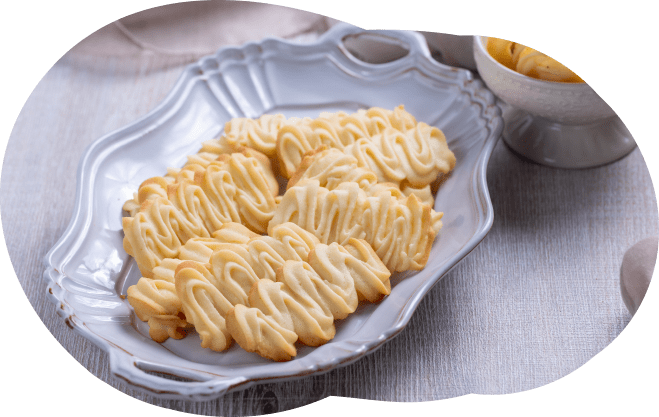Butter from Europe (and specifically from France) has a reputation for quality that drives many chefs to purchase it. But what does science tell us about making pastry with European butter versus American? Are there reasons or specific circumstances when U.S. chefs should look across the pond for their dairy?
Chef Jamie Simpson, Executive Chef Liaison at The Culinary Vegetable Institute, says “Butter has a few leading roles for thanksgiving, but it’s really on stage throughout the entire performance. From the dinner rolls at the opening scene to the pie crust at the finale, butter is there to enhance the show every step of the way. Generally speaking, commercially available butter is better when it’s from Europe. It’s more buttery, it’s denser, and it’s more memorable than the commodity butter made here in the U.S. When you’re checking off your shopping list this season, don’t cut corners – go European with your butter. The mashed potatoes will thank you!”

To answer these questions, it’s helpful to understand how butter is made and what happens when it is cooked in pastry. “Butter is made from cream, which is an emulsion of small droplets of fat suspended in water,” says Kierin Baldwin, chef-instructor of Pastry & Baking Arts at the Institute of Culinary Education in New York City. The process of churning causes the dispersed fat droplets in the cream to glom onto each other and form a mass of fat with a small amount of liquid still trapped in it. This mass is what we know as butter.
Not all butters are the same. In America, butter must be made with at least 80 percent butter fat, according to Joanna Shawn Brigid O’Leary, PhD, a culinary consultant and food critic. (It will also contain 16 to 18 percent water and 2 to 4 percent other ingredients, such as salt.) European butters must have a minimum of 82 percent butter fat. These numbers are minimums, so it’s possible to find American-made produpxcts with a higher percentage of butter fat. However, many chefs reach for French or other European butters when they need that higher fat content because they know the product will deliver.

There are a few other differences. “Most European butters are usually cultured as well, which gives them a pleasant tang,” says Baldwin. Farmers in Europe are more likely to raise their cows on pastures (not in feedlots with a diet of corn) and less likely to use additives. These variables can have a major impact on the terroir or sense of place that contributes to the taste of the butter, O’Leary says.
So, is it better to use European or American butter in pastry? The answer depends on the baker’s goal. If you want a rich, buttery flavor, a higher fat content butter is best, which means a French or European product may be the right choice. The fat is where the flavor resides, so more fat means more flavor. In addition, when butter is blended with other ingredients, it creates small pockets in the pastry. “The butter has a tendency to stay in those pockets, not distribute throughout the food,” says O’Leary. “The taste becomes more magnified because when you have higher butter fat, you have more pockets.”

Things like butter cookies or kouign-amann, which take most of their flavor characteristics from butter, are ideal candidates for European butter, Baldwin says. She adds, “Any type of recipe that depends on the fat in butter for either leavening or shortness will do best with a high fat butter. Things that fall into these categories are laminated doughs, such as puff pastry, croissant and Danish; pie doughs and other flaky cut-in butter preparations; and creamed butter cakes and cookies.”
Butter’s molecular structure means it lends a smoother mouthfeel to baked goods. Butter is a saturated fat, which means there are single bonds between the carbons in its chemical structure rather than double bonds, says O’Leary. Whereas the double bonds found in unsaturated fats like oils cause them to be liquid at room temperature, the single bonds mean butter is solid. That’s also what gives butter its rich, robust flavor.
In O’Leary’s experience, lower-fat butter works well in baked goods that need to be lighter and fluffier. The added water creates more steam to leaven items and there is less fat to weigh down the ingredients. Lower-fat butter is also ideal for baked goods where the flavor of sugar or other ingredients—not butter—should be the standout.

Beyond considerations related to butter fat, O’Leary recommend that chefs make sure they store butter correctly and use it soon after buying. “Fat absorbs liquids easily. Even if you store butter near a liquid that’s pungent, it can absorb that flavor quite easily. I would also pay really close attention to how long it’s been on the shelf and how it’s been stored, because exposure to light can alter the quality.” If possible, visit the brand’s website and read their suggestions on exactly how to store their butter for the best results.
“The most important thing to concentrate on when you are using butter in a recipe is being consistent,” says Baldwin. If a recipe has been tested with a higher-fat butter and a lower-fat product is substituted, the ratio of liquids to other ingredients is likely to be off and the recipe will not work as well. Stick to European butter for recipe that call for it to be results that will wow every time.
this article originally appeared in the October 2022 issue of pastry arts magazine.